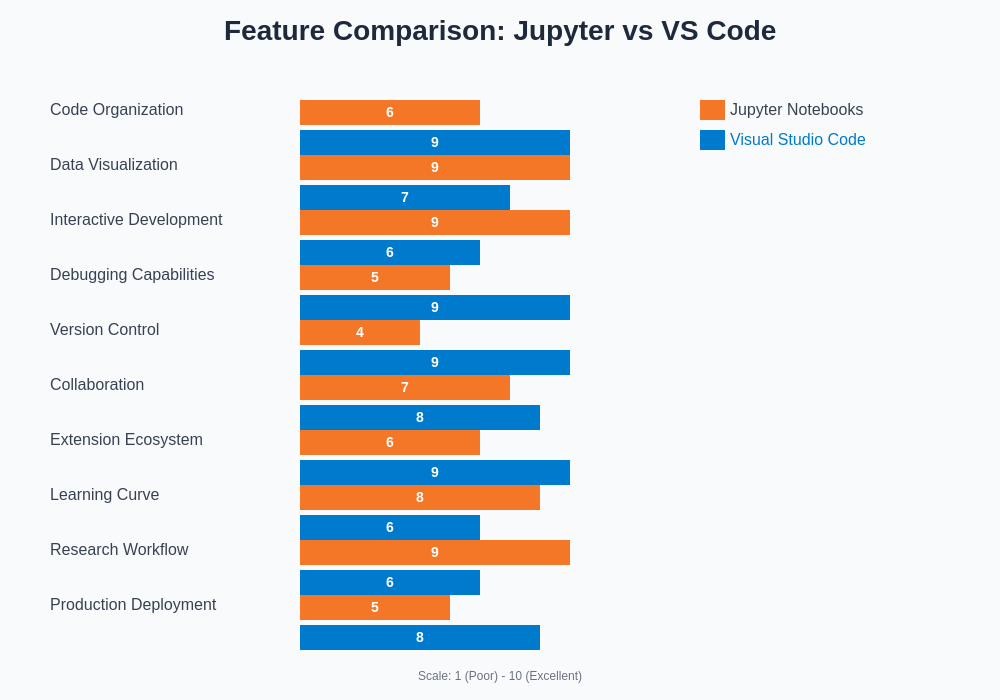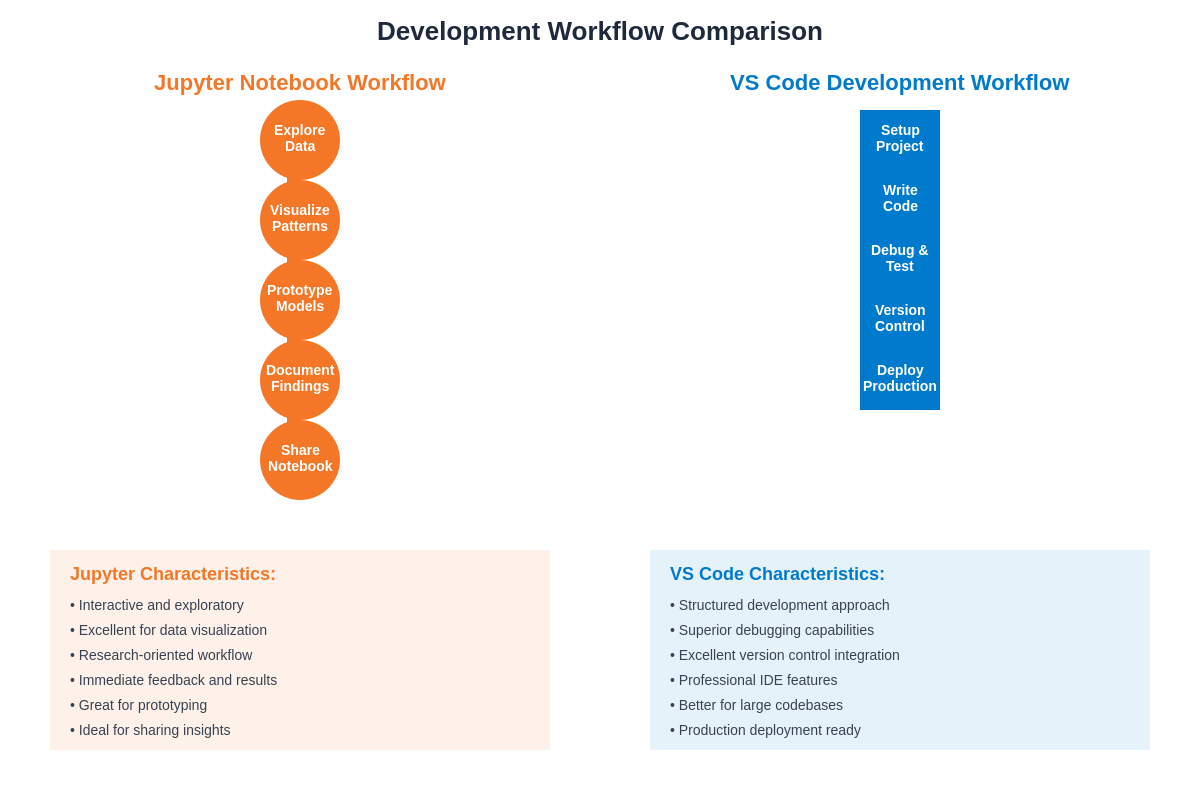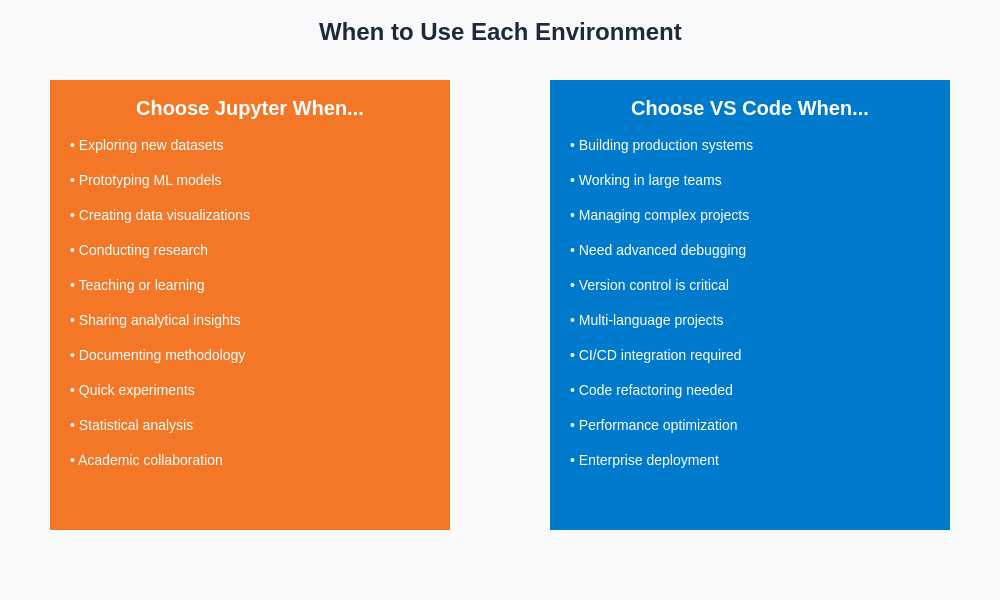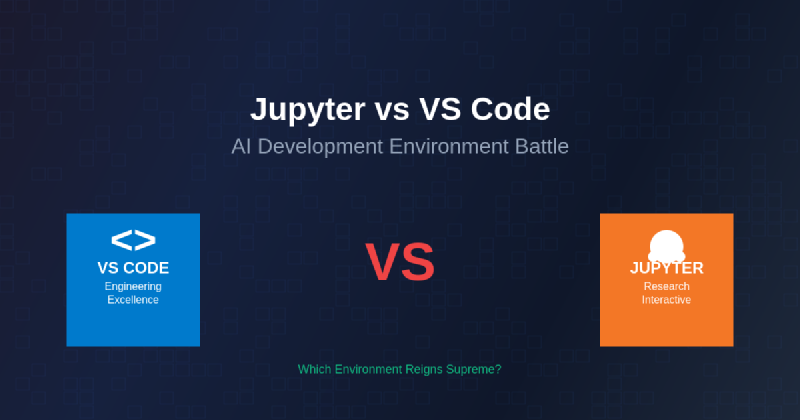The artificial intelligence and machine learning development landscape has witnessed an ongoing debate between two powerhouse development environments: Jupyter Notebooks and Visual Studio Code. This battle for supremacy in AI development represents more than a simple preference between tools; it embodies fundamentally different philosophies about how data scientists, machine learning engineers, and AI researchers should approach their craft. Each environment offers unique advantages that cater to different aspects of the AI development lifecycle, from initial data exploration and prototyping to production deployment and collaborative research.
Stay updated with the latest AI development trends to understand how these development environments are evolving to meet the changing needs of the AI community. The choice between Jupyter and VS Code often determines not just individual productivity but also shapes team workflows, project maintainability, and the overall approach to AI system development and deployment.
Understanding the Development Environment Landscape
The evolution of AI development environments reflects the maturation of the field itself, transitioning from academic research tools to enterprise-grade development platforms. Jupyter Notebooks emerged from the scientific computing community, emphasizing interactive exploration, visual feedback, and narrative-driven development that mirrors the research process. This approach prioritizes immediate feedback, iterative experimentation, and the seamless integration of code, documentation, and visualizations within a single, cohesive interface.
Visual Studio Code, conversely, represents the software engineering approach to AI development, bringing industrial-strength development practices, comprehensive tooling, and scalable project management capabilities to the machine learning domain. This environment emphasizes code organization, version control integration, debugging capabilities, and the structured development practices that have proven essential for building reliable, maintainable software systems at scale.
The fundamental tension between these approaches reflects a broader question in AI development: whether machine learning projects should be approached as research endeavors requiring flexibility and experimentation, or as software engineering projects demanding structure, reproducibility, and maintainability. The reality is that successful AI projects often require both approaches at different stages of their lifecycle.
Jupyter Notebooks: The Research-Centric Approach
Jupyter Notebooks have established themselves as the gold standard for exploratory data analysis, prototyping machine learning models, and conducting research in artificial intelligence. The notebook interface provides an intuitive environment where code execution, data visualization, and documentation coexist seamlessly, enabling researchers and data scientists to develop their thinking alongside their code in a natural, iterative manner.
The cell-based execution model that defines Jupyter allows for non-linear development workflows where different sections of code can be executed independently, modified, and re-run without affecting the entire program flow. This flexibility proves invaluable during the data exploration phase, where understanding data distributions, identifying patterns, and testing hypotheses requires rapid iteration and immediate visual feedback.

The comprehensive feature analysis reveals distinct strengths in each environment, with Jupyter excelling in interactive development and data visualization capabilities, while VS Code demonstrates superior performance in code organization, debugging, and production deployment scenarios.
Jupyter’s strength in data visualization cannot be overstated, with native support for inline plotting through libraries like Matplotlib, Seaborn, and Plotly, creating an environment where data insights can be immediately visualized and shared. This capability makes Jupyter particularly attractive for data scientists who need to communicate findings to stakeholders, as the narrative structure of notebooks allows for storytelling through data that combines analysis, visualizations, and explanatory text.
Enhance your AI development workflow with Claude’s advanced capabilities for code generation, debugging, and architectural guidance that works seamlessly across different development environments. The integration of AI assistants into development workflows has become increasingly important for maximizing productivity and maintaining code quality.
Visual Studio Code: The Engineering Excellence Platform
Visual Studio Code brings the rigor and sophistication of professional software development to AI and machine learning projects, offering a comprehensive suite of tools that support the entire development lifecycle from initial conception to production deployment. The IDE’s extensibility through its rich ecosystem of extensions allows developers to customize their environment for specific AI development needs while maintaining the structure and organization essential for collaborative development.
The integrated development environment excels in areas where Jupyter traditionally struggles, particularly in code organization, project structure, and version control integration. VS Code’s native Git integration, combined with sophisticated diff tools and merge conflict resolution, makes it superior for team-based AI development where code collaboration, branching strategies, and version management are critical for project success.
VS Code’s debugging capabilities represent a significant advantage for complex AI applications, providing step-through debugging, variable inspection, and performance profiling tools that are essential for understanding and optimizing machine learning algorithms. The ability to set breakpoints, examine data structures, and trace execution flow becomes invaluable when working with complex neural networks, optimization algorithms, or data processing pipelines.
The IntelliSense features and code completion capabilities in VS Code significantly enhance developer productivity by providing context-aware suggestions, function signatures, and documentation lookup, reducing the cognitive load associated with remembering API details and library functions. This becomes particularly valuable when working with large machine learning frameworks like TensorFlow, PyTorch, or scikit-learn.
Performance and Resource Management
The performance characteristics of these two environments reveal fundamental differences in their architecture and intended use cases. Jupyter Notebooks, running in a browser environment, can consume significant system resources, particularly when dealing with large datasets or complex visualizations. The persistent kernel model means that variables and objects remain in memory throughout the session, which can lead to memory accumulation over time and requires careful resource management.
Visual Studio Code, being a native application, generally offers better resource utilization and more predictable performance characteristics. The IDE’s ability to handle large codebases without significant performance degradation makes it more suitable for enterprise-scale AI projects where performance and reliability are critical concerns.
However, Jupyter’s architecture provides advantages in certain scenarios, particularly for long-running experiments or iterative model training where maintaining state between code executions is beneficial. The ability to execute cells independently allows for efficient resource utilization during exploratory phases where only specific code sections need to be re-run.
Collaborative Development and Version Control
The collaborative aspects of AI development reveal stark differences between these environments. Jupyter Notebooks present unique challenges for version control systems due to their JSON-based format that includes metadata, execution counts, and output data. These characteristics can create merge conflicts and make it difficult to track meaningful changes in collaborative development scenarios.
Visual Studio Code’s superior Git integration and traditional file-based project structure make it more suitable for team-based development where multiple developers need to work on the same AI project. The IDE’s support for branching, merging, and conflict resolution enables sophisticated collaboration workflows that are essential for large-scale AI development projects.
However, Jupyter’s sharing capabilities through platforms like GitHub, nbviewer, and cloud-based notebook services provide excellent mechanisms for sharing research, tutorials, and exploratory analyses. The self-contained nature of notebooks makes them ideal for communicating results and methodologies to broader audiences.
Leverage Perplexity’s research capabilities to stay informed about the latest developments in AI development tools, best practices, and emerging technologies that can enhance your development workflow regardless of your chosen environment.
Extension Ecosystems and Customization
The extensibility of both environments plays a crucial role in their effectiveness for AI development. Visual Studio Code boasts an extensive marketplace with thousands of extensions specifically designed for data science, machine learning, and AI development. Extensions like Python, Pylance, Jupyter (for notebook support within VS Code), and various AI-specific tools create a highly customizable development environment.
Jupyter’s extension ecosystem, while smaller, focuses specifically on notebook enhancement and scientific computing workflows. Extensions like JupyterLab provide a more IDE-like experience while maintaining the notebook paradigm, and specialized extensions for specific domains like bioinformatics, geospatial analysis, or financial modeling extend Jupyter’s capabilities in targeted ways.
The magic commands system in Jupyter provides unique functionality for AI development, offering shortcuts for common operations like timing code execution, profiling performance, and interacting with the shell. These commands streamline many routine tasks in data science workflows and provide capabilities that are not easily replicated in traditional IDEs.
Deployment and Production Considerations
The transition from development to production represents a critical phase where the choice of development environment significantly impacts project success. Jupyter Notebooks, while excellent for exploration and prototyping, require additional tooling and conversion processes to deploy models in production environments. Tools like nbconvert, papermill, and various cloud platforms provide pathways for operationalizing notebook-based workflows, but this often requires architectural changes and additional complexity.
Visual Studio Code’s alignment with traditional software development practices makes the production deployment process more straightforward. The modular code organization, integrated testing capabilities, and CI/CD pipeline support enable smoother transitions from development to production deployment. This advantage becomes more pronounced as AI projects scale and require robust deployment pipelines.
However, the rise of cloud-based notebook services and MLOps platforms has begun to bridge this gap, providing notebook-to-production workflows that maintain the research-friendly development experience while enabling scalable deployment options.
Machine Learning Workflow Integration
The integration with machine learning workflows and MLOps practices reveals different strengths in each environment. Jupyter Notebooks excel in the experimental and exploratory phases of machine learning projects, providing an ideal environment for data preprocessing, feature engineering, model experimentation, and results visualization. The interactive nature of notebooks supports the iterative, hypothesis-driven approach that characterizes effective machine learning development.
Visual Studio Code provides superior support for the engineering aspects of machine learning projects, including automated testing, continuous integration, model versioning, and deployment automation. The IDE’s support for containerization, cloud deployment, and infrastructure-as-code practices aligns well with modern MLOps requirements.
The emergence of hybrid approaches, such as using Jupyter notebooks for experimentation and VS Code for implementation and deployment, represents a practical solution that leverages the strengths of both environments while mitigating their respective limitations.

The workflow comparison illustrates the fundamental philosophical differences between these environments, with Jupyter emphasizing exploratory, research-oriented processes and VS Code focusing on structured, engineering-driven development practices that scale effectively to enterprise requirements.
Learning Curve and Accessibility
The accessibility and learning curve associated with each environment significantly impact their adoption and effectiveness for different user types. Jupyter Notebooks provide a gentler introduction to programming and data science, with their visual, interactive interface that immediately shows results and provides feedback. This accessibility makes Jupyter particularly attractive for educational purposes, research collaboration, and interdisciplinary teams where not all members may have extensive programming backgrounds.
Visual Studio Code, while more complex initially, provides a more comprehensive development environment that scales better as projects grow in complexity and team size. The investment in learning VS Code’s features and capabilities pays dividends for developers working on large, long-term AI projects where code organization, debugging, and collaboration are critical success factors.
The documentation and community support for both environments are extensive, with Jupyter having strong representation in academic and research communities, while VS Code enjoys broad support from the software development community and enterprise users.
Integration with AI and ML Libraries
The compatibility and integration with popular AI and machine learning libraries reveal subtle but important differences between the environments. Jupyter’s origins in the scientific Python ecosystem ensure excellent support for libraries like NumPy, Pandas, Scikit-learn, and visualization libraries. The notebook format is particularly well-suited for libraries that produce rich output formats, interactive widgets, and complex visualizations.
Visual Studio Code’s strength lies in its comprehensive support for multiple programming languages and frameworks, making it superior for polyglot AI projects that might combine Python for machine learning with JavaScript for web interfaces, C++ for performance-critical components, or R for statistical analysis. The IDE’s language server protocol provides consistent development experience across different languages.
Both environments support popular deep learning frameworks like TensorFlow and PyTorch effectively, though they excel in different aspects of the development workflow. Jupyter provides better support for interactive model training and results visualization, while VS Code offers superior debugging and code organization capabilities for complex model architectures.
Cloud Integration and Remote Development
The evolution of cloud computing and remote development capabilities has significant implications for both environments. Jupyter’s web-based architecture naturally aligns with cloud deployment, making it easy to run notebooks on remote servers, cloud platforms, or containerized environments. Services like Google Colab, Azure Notebooks, and AWS SageMaker provide managed Jupyter environments with access to powerful computing resources.
Visual Studio Code’s remote development capabilities, including Remote-SSH, Remote-Containers, and GitHub Codespaces, enable seamless development on remote machines while maintaining the full IDE experience. This capability is particularly valuable for AI development where training requires powerful GPUs or large-scale computing resources that may not be available locally.
The integration with cloud-based AI services, such as Azure Machine Learning, AWS SageMaker, or Google Cloud AI Platform, varies between the environments, with each offering specific advantages depending on the chosen cloud provider and deployment strategy.
Future Trends and Evolution
The ongoing evolution of both environments suggests a convergence of features and capabilities rather than a clear winner in the battle for AI development supremacy. Jupyter continues to add more IDE-like features through JupyterLab and extensions, while VS Code has integrated notebook support and improved its data science capabilities.
The rise of AI-powered development assistants, code generation tools, and automated machine learning platforms is likely to impact both environments significantly. The integration of these capabilities will determine which environment better supports the next generation of AI development workflows.
The emergence of new paradigms like notebook-first development, literate programming for machine learning, and interactive computing suggests that the future may belong to hybrid approaches that combine the best aspects of both environments rather than favoring one over the other.
The continued growth of the AI development community, with diverse backgrounds ranging from academic researchers to software engineers, suggests that both environments will continue to evolve and serve different segments of this expanding ecosystem.
Making the Strategic Choice
The decision between Jupyter and VS Code for AI development should be based on careful consideration of project requirements, team composition, deployment strategy, and long-term maintenance needs. For research-oriented projects, rapid prototyping, educational purposes, and scenarios where data exploration and visualization are paramount, Jupyter Notebooks provide an optimal development environment.
For production-oriented AI systems, large-scale collaborative projects, complex architectures requiring sophisticated debugging, and scenarios where code maintainability and deployment automation are critical, Visual Studio Code offers superior capabilities and tooling support.
The most successful AI development teams often adopt a pragmatic approach, using Jupyter for exploration and research phases and transitioning to VS Code for implementation, testing, and deployment phases. This hybrid strategy leverages the strengths of both environments while minimizing their respective limitations.

The strategic selection criteria provide clear guidance for choosing the appropriate environment based on project requirements, team composition, and development objectives, ensuring optimal productivity and project success across different AI development scenarios.
The choice ultimately depends on balancing immediate productivity needs with long-term project goals, team expertise, and organizational requirements. Both environments continue to evolve and improve, suggesting that the competition between them drives innovation that benefits the entire AI development community.
Disclaimer
This article provides a comparative analysis based on current features and capabilities of Jupyter Notebooks and Visual Studio Code for AI development. Tool capabilities, performance characteristics, and feature sets are subject to ongoing development and may change over time. Readers should evaluate tools based on their specific requirements, team needs, and project constraints. The effectiveness of either environment depends on proper configuration, team expertise, and alignment with project objectives.
